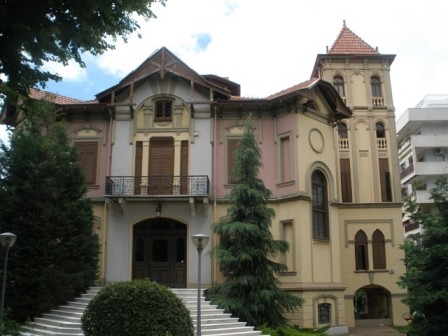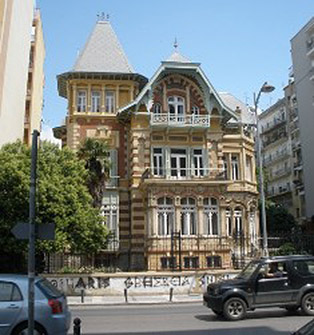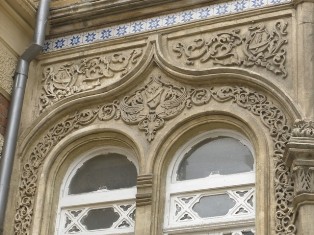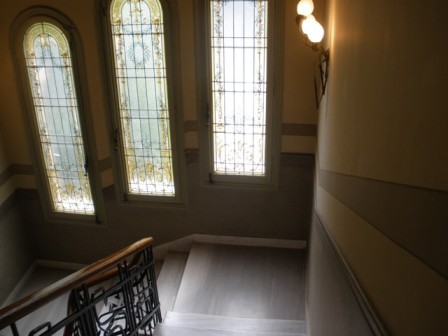As the nineteenth century drew to a close, the centuries-old Ottoman Empire was crumbling. In remote corners of its vast dominion – on the backroads and in far-flung villages – life was fraught with danger. Yet in Macedonia, the situation was nothing short of unbearable. Revolutionaries, brigands, and warring insurgents from various nations each pursued their own “righteous” causes, with terror as their preferred weapon. Venturing into the more distant reaches of the province became a perilous adventure, and even a respectable traveller could easily lose their head a mere 20 or 30 kilometres from Salonica (modern-day Thessaloniki).
And yet, within Salonica itself, life remained relatively normal. In this intricate tapestry of religious and national identities – where Spanish Jews formed the majority of the population – religious tolerance was exemplary, and Western liberal ideas found fertile ground among the urban elite. The city emerged as a beacon of progress and modernisation. The arrival of the railway, the advent of trams, and the introduction of electric streetlights instilled a sense of security in a segment of society that chose to overlook the empire’s disintegration and instead focused on improving their quality of life. Educated in the West, they immersed themselves in art, built splendid homes, and decorated them in the irresistible style of the late Ottoman oriental bourgeoisie. They enlisted the expertise of two distinguished local architects, Italians Vitaliano Poselli and Pietro Arrigoni, who had made Salonica their home. Some of the wealthiest citizens were Jews, others were Sabbateans (also known as Dönmeh – followers of Sabbatai Zevi, a 17th-century messiah), some were Westerners, and there were also Turks, Greeks, Aromanians, and members of other Balkan ethnic groups. Together, they constructed a new, progressive world – unaware that they were building it atop the crater of a volcano.
By the time they realised what was happening, it was already too late. The luckier ones managed to escape with their lives and were exiled to Turkey, while for the majority who remained, Auschwitz became the final destination. Left behind were their family villas, the headquarters of their businesses, and their religious and public buildings – nearly all designed by the aforementioned Italian architects. These structures still stand in Thessaloniki today, drawing wistful gazes from art enthusiasts and incurable nostalgists alike.
Poselli and Arrigoni
The decline of the Ottoman Empire was not a one-way process. Some of its last sultans, and particularly their principal adversaries, the Young Turks, made earnest efforts to modernise the country in a race against time. In this wave of modernisation, architects and engineers from the West were warmly welcomed, and Italians, more than others, seized this opportunity.
In Constantinople, Raimondo d’Aronco, the Sultan’s court architect, stood out both for his masterful reinterpretations of traditional Oriental motifs in contemporary structures and for his striking Art Nouveau buildings, which became defining landmarks of the metropolis. In Smyrna (modern-day Izmir), elegant villas for the Levantines (a term used locally for descendants of Genoese and Venetian merchants) were designed by architects of Italo-Levantine descent: Storari, Rossetti, Molli, Mongeri. In Salonica, however, the architectural stage belonged unquestionably to the brilliant Vitaliano Poselli and Pierro Arrigoni.
The Sicilian architect Vitaliano Poselli(1838–1918) first attempted to establish his career in Constantinople, but his work eventually led him to Salonica, where he began creating in 1886. In Salonica, Poselli was entrusted with the city’s most prestigious projects: leading banks, the Ottoman administrative building, and an unusually diverse range of religious structures – a synagogue, an Armenian church, a Catholic church, and the Yeni Djami, a Sabbatean mosque.
Pierro Arrigoni (1856–1940), a native of Turin, followed in the footsteps of his older colleague in Salonica. Since major state projects were invariably awarded to Poselli, Arrigoni turned his focus to designing villas for private investors from the city’s affluent mercantile families, achieving remarkable success in this domain.
The Villas of Salonica
At the close of the 19th century, wealthy industrialists and merchants – Jews, Dönmeh (Sabbateans), and foreigners – began constructing their residences in the southern part of the city, leaving only the headquarters of their businesses in the city centre’s Frankomahala (the French Quarter). The finest villas of Salonica’s elite are situated along a several-kilometre-long street that leads southward, known today as Vassilissis Olgas Street (Queen Olga Street). In this unusual and spontaneously developed urban concept, a series of modern, uniform six-storey buildings are interspersed with charming, richly adorned villas built over a century ago.
Let this text serve as a nostalgic promenade along this historic street, with a special focus on the villas designed by Arrigoni and Poselli.
Mehmet Kapandji’s Villa – 108 Vassilissis Olgas Street
Known today as the Kapandji Villa, this eclectic-style residence was built around 1893 to Pierro Arrigoni’s design, serving as the home of Mehmet Kapandji, a wealthy banker and textile merchant from a prominent Sabbatean family.

When Salonica was annexed to Greece in 1912, the villa housed the city’s first Greek military commander, Prince Nicholas. Later, during the First World War, when the pro-British Greek government broke away from the pro-German king and established its base in Salonica, Prime Minister Venizelos resided in the Kapandji’s villa. Up until 1972, the building served as a boys’ secondary school, after which it was acquired by the National Bank of Greece. Thoroughly restored by the bank, the villa has, since 1989, been used as a venue for exhibitions organised by the bank’s cultural foundation.
Ahmet Kapandji’s Villa – 105 Vassilissis Olgas Street
Not far from Mehmet Kapandji’s villa stands another eclectic gem – the residence of his younger brother, Ahmet Kapandji. Built around 1895, it was also designed by Pierro Arrigoni. Following the expulsion of the Sabbateans to Turkey in 1923, the villa came under Greek state ownership and has since served as a favoured location for state institutions. During the Second World War, Ahmet Kapandji’s villa housed the Gestapo headquarters. Decades later, when Thessaloniki was designated the European Capital of Culture in 1997, this villa housed the offices of the organisational centre for the event. Surprisingly, fifteen years on, the offices of that centre are still housed in the villa, with staff continuing to work there and receive salaries.


Villa Allatini – 198 Vassilissis Olgas Street
The residence of the wealthy Jewish industrialist Carlo Allatini, built around 1896 to Poselli’s design, is the most impressive villa in Salonica. As soon as it was completed, it emerged as one of the city’s iconic landmarks, though today it is partially concealed by the dense canopy of trees in the expansive park that surrounds it. The luxury that Allatini envisioned for himself has significantly influenced the villa’s subsequent history. It is known that for a time, the villa housed the head of the international gendarmerie, Italian General Robilot. When, in 1908, the Young Turks seized power, the villa was suitably chosen to serve as a dignified house arrest for the deposed Sultan Abdul Hamid II. Thus, Villa Allatini welcomed its most demanding resident, accustomed to a life of opulence both at court and in captivity.
In 1912, the victorious Greek army took over the building. Later, it served as a university, then a health centre, and since 1979, it has been the premises of the Ministry of the Interior.
Dino Fernandez’s Villa – Casa Bianca – 180 Vassilissis Olgas Street
Designed by Arrigoni around 1910 for the merchant and industrialist Dino Fernandez, the villa is still known today as Villa Bianca or Casa Bianca, named after the owner’s wife. Located within a spacious park, the villa is a beautiful example of Art Nouveau architecture. Today, it houses an art gallery.

Other Villas on Vassilissis Olgas Street
Visitors wishing to stroll along Vassilissis Olgas Street will encounter numerous villas from Salonica’s fin de siècle period. While some of these are still in ruins, the fact that the land has not been sold for new development indicates the city authorities’ intention to eventually restore them.
The house of Beni Fernandez (144 Vassilissis Olgas Street), also known as the Hirsch House, was designed by Arrigoni for another member of the Fernandez family, and is currently in ruins, awaiting renovation.
The Modiano Villa (68 Vassilissis Olgas St.), which older residents remember as the Government Building, was designed by Eli Modiano, a Salonica architect educated in Paris, for his father, the wealthy Jewish merchant Jakov Modiano. Today, it is home to the Museum of Folk Art, though it has previously served as the headquarters of the Government of the Province of Macedonia, a military school, and a religious institution.
The magnificent Turkish-Baroque Mordoch Villa (162 Vassilissis Olgas St.) is now an art gallery.
The beautiful house known as the “Salem Mansion” is yet to be restored.
The neoclassical Osman Ali Bey House, or “Melisa” Villa (36 Vassilissis Olgas St.), now serves as the Byzantine Research Centre.
The Hafiz Bey Villa (32 Vassilissis Olgas), one of the largest and most beautiful, has been carefully restored. Between the two world wars, it was home to the exiled Kosovo-Albanian politician Hasan Prishtina, one of the few Muslims in a city from which they had been officially expelled. However, he was soon assassinated, allegedly by order of either Albanian King Zog or the Yugoslav secret service. Today, the villa houses a school for blind and visually impaired children.
Epilogue
For centuries, Salonica was a peaceful, business-oriented city, renowned for its exemplary religious tolerance – the last echo of the vanished Al-Andalus from which most of its population descended. For nearly five hundred years, the city was spared from war and natural disasters, but the first half of the twentieth century exacted a heavy toll, akin to the punitive interest of a merciless loan shark. During this period, Salonica became the epicentre of a series of wars, revolutions, refugee crises, assassinations, fires, and genocides. By the time the dust settled, nothing was the same. The old city burned to the ground, its minarets were demolished, Muslims and Sabbateans were expelled, and its Jewish population exterminated, replaced by embittered Greek refugees from Asia Minor. The surnames that once dominated the city – Allatini, Kapandji, Modiano, Fernandez – had no living descendants to carry them on. Even the Italian architects who shaped the city’s skyline, Poselli and Arrigoni, shared its fate, remaining loyal to Salonica until their deaths. Poselli passed away in 1918, at the dawn of the city’s irreversible transformation, and Arrigoni was killed in Salonica in 1940, never living to witness yet another devastating, final blow to the city he had known.
Remarkably, only two buildings, both designed by Poselli, emerged unscathed from the city’s turmoil and have preserved their original roles: a modest Armenian church near the White Tower and the Catholic church in Frankomahala.
Darko Veselinović, August 2012



